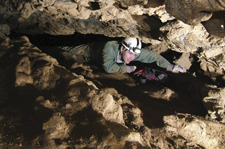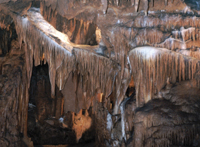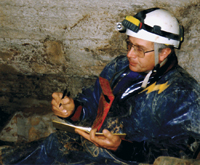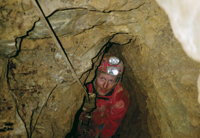The
Beauty Beneath Your Feet
by
Deborah R. Huso, Contributing Writer
|

Bath
County resident Matt Campagna navigates a narrow passage in one of
Virginia's multitudinous non-commercial caves.
|
While Virginia�s Shenandoah Valley is
renowned for its scenic beauty, one of its most
stunning features is actually under the ground.
Living in Highland County, I find it
difficult not to be intrigued by what�s under the ground. Our landscape here, just west of the Shenandoah
Valley, is one where sinkholes attest to a world existing beneath
us � a world full of dark chambers, flowing water, and formations of
flowstone never yet seen by man. Once, behind my house near Bolar Springs, I
came across a hole in the ground, its mouth marked by a ring of rock, a
crooked tree just above it with an old rope attached, a rope that extended
down into the hole. I peered into the blackness wondering who had been brave
enough to crawl into that dark netherworld. Many times I returned to the
spot, trying to imagine what might be down there. A single dark chamber?
Tunnels curving beneath the mountain for miles? Formations that would
glisten against the illumination of a flashlight?
Venturing into a wild cave alone seemed
too much for me. But that�s how many of Virginia�s show caves were
discovered � once a boy, or a dog, or an adventurous farmer found an
entrance into the earth, then someone went in and discovered a vast, strange
world dripping with the life of slowly growing stalactites. That�s how
Virginia�s most popular cavern at Luray came to be � discovered by a
local tinsmith and his friends in 1878. It has been a show cavern almost
ever since, even drawing the attention of North Pole explorer Jerome J.
Collins and the Smithsonian Institution.
How the Valley�s Caves
Began
Given the ease with which we can visit a
place like Luray Caverns today, it�s difficult to imagine just how ancient
the caves of the Shenandoah Valley are. They�ve been formed over
millennia, starting with the movement and breaking-up of continents 600
million years ago. Caverns like those in Luray formed when a prehistoric sea
drained out of a massive basin running from Newfoundland to Alabama. With
the uplift of the Appalachian Mountain range and the drainage of vast areas
of water, caverns began to form and inside them a multitude of otherworldly
formations.
When one considers that at Luray
Caverns, deposits of crystallized calcite, which form stalactites and
stalagmites, grow at a rate of one cubic inch every 120 years or so, the
insignificance of a human lifespan becomes clear. Perhaps that�s part of
what draws half-a-million visitors a year to this Shenandoah Valley
attraction.
Luray Caverns
|

"Frozen
Fountain" at Luray Caverns. All formations in the caverns are
calcite, a crystalline form of linestone, the result of linestone
dissolved in water, then re-depositied in the hollowed-out
underground chambers as stalactites and stalagmites. |
Luray Caverns� history is almost as
interesting as its formations. In 1901, 23 years after the cavern�s
discovery, Col. T.C. Northcott leased the property and used the caverns to
generate air conditioning by putting a five-foot-diameter shaft with an
electric fan into one of the cave�s chambers to push cool air into the
sanitarium he built over the caverns. Northcott called it the first
air-conditioned home in the U.S., as the fresh and clean cavern air
maintained a temperature of about 70˚F throughout the building.
Today visitors to Luray Caverns can
still enjoy natural air conditioning. The caverns maintain a temperature of
about 54˚F year-round. A designated National Landmark, the caverns are
the largest in the East and feature a variety of aptly named chambers,
including Giant�s Hall, which is dominated by 10-story- high gold columns.
Luray is perhaps best known for its stalacpipe organ, a real organ that
creates sound through the use of stalactites as organ pipes. Over
three-and-a-half acres of stalactites are fitted with rubber mallets wired
to the organ to bellow out eerily beautiful music. (540) 743-6551, www.luraycaverns.com.
Shenandoah Caverns
Shenandoah Caverns, near Mt. Jackson,
was discovered in 1884, during construction of the Southern Railway when
local blasting activity exposed vapor rising from a crevice in the earth,
drawing some boys to explore the crevice. What they found, with only the
help of some candles, was a vast underground room with dripping, glistening
formations. Today the caverns is known for its 17 underground rooms,
accessible via elevator. The site has been open to the public since 1922.
Among the unique features of Shenandoah
Caverns is Rainbow Lake, where a pool is surrounded by multi-colored
dripstone, and Diamond Cascade, a massive pointed calcite crystal formation
all in white. Visitors also enjoy Shenandoah�s bacon formations, which
literally look like massive strips of pink bacon stretched out against the
walls. Visitors should also be sure to look for Shenandoah Caverns� pixie,
the cavern mascot developed in the 1960s, who can still be found hiding at
various places among the underground formations. (540) 477-3115, www.shenandoahcaverns.com.
Grand Caverns
|

The
"Ski Slope" at Grand Caverns. |
Located near Natural Chimneys, Grand
Caverns is the nation�s oldest show cave, having offered public access
since 1806. Despite its name, it�s not the largest in the Valley, but does
have the most well-documented history. During the Civil War, both
Confederate and Union soldiers visited the caverns and wrote their names on
the walls. 230 of those signatures have been verified, and some are visible
to visitors on the cavern tour. Legend says that General Stonewall Jackson
refused to tour the caverns, explaining, �I fear I shall be underground
soon enough, and I have no desire to speed the process.� Today visitors to
the caverns can explore Cathedral Hall, a vast underground room 280 feet
long and more than 70 feet high. Drapery-like flowstone garnishes the walls,
while thick and massive columns stretch from floor to ceiling. Other
signature formations of Grand Caverns include the Bridal Veil, Stonewall
Jackson�s Horse, and Dante�s Inferno. (888) 430-2283, www.uvrpa.org/grandcaverns.htm.
a
one-of-a-kind attraction
Luray Caverns� Great Stalacpipe Organ
is the world�s largest musical instrument. This one-of-a-kind wonder was
conceived by Mr. Leland W. Sprinkle of Springfield, a mathematician and
electronics scientist at the Pentagon. After visiting the caverns with his
son and experiencing the sounds of a stalactite being tapped, Mr. Sprinkle
submitted a complex plan for the instrument. It took 36 years of research,
design and experimentation to build. Three years alone were spent searching
the caverns to select and carefully sand stalactites to precisely match the
musical scale; only two stalactites were found to be in tune naturally. The
four-keyboard console was constructed by the Klann Organ Supply Company of
Waynesboro to meet the peculiar needs of a subterranean installation. The
organ is connected to various stalactites by over five miles of wiring.
Today, the organ is played by an automated system, but can also be played
manually from the console, as Leland Sprinkle did for many years.
A
Glossary of Formations
More
Shenandoah Valley Caverns To Visit
Natural
Bridge Caverns
Natural
Bridge
(800)
533-1410
www.naturalbridgeva.com
Endless
Caverns
New
Market
(800)
544-CAVE (2283)
www.endlesscaverns.com
Skyline
Caverns
Front
Royal
(800)
296-4545
(540)
635-4545
www.skylinecaverns.com
Crystal
Caverns
Strasburg
(540)
465-5884
www.waysideofva.com/crystalcaverns
Virginia�s Wild
Cavers: Why They Love the Underground
|

Seasoned
spelunker Rick Lambert. |
Many of us have experienced a trip into
the earth via one of Virginia�s many commercial caves, our path happily
brightened by hundreds of strategically placed lights and paved walkways
leading us into underground rooms of brightly colored formations, clear
spring pools, and artifacts of man�s earliest trips into darkness. But
this isn�t all there is to exploring Virginia�s underground world. The
mountains west of the Blue Ridge, rich with limestone eroded into tunnels
and rooms by centuries of seeping groundwater, are home to caves by the
hundreds, most of them privately held and not accessible to the general
public.
But for those among us who are serious
spelunkers, who have no fear of mud, water, slime, and darkness, the wild
caves of Virginia offer endless opportunities for discovery, scientific
research, and a view into a world untouched by time.
Serious Spelunker: Phil
Lucas
It is an understatement to say that Phil
Lucas of Burnsville takes caving seriously. He has been president of the
Virginia Speleo�logical
Survey (VSS) since 1974, and now retired, he devotes himself full-time to
the exploration, mapping, and surveying of Virginia�s caves. He says there
are 4,378 known caves in the Commonwealth, most occurring in 26
limestone-heavy counties west of the Blue Ridge. One of those counties,
Highland, is where Lucas has made his home for the last six years,
appropriately enough on a 160-acre farm that holds entrances to six caves.
Lucas says he first became interested in
caves as a young boy growing up north of Harrisonburg, where, by age 7, he
had already spent some time in commercial caves and had traipsed along with
his brother and a friend who discovered a cave near Lucas� boyhood home.
�I was enthralled,� he says of his first trip into that wild cave that
he later revisited as an adult. �As a kid, I stuck a bunch of candles in
my hip pocket and hopped on my bicycle to go caving.�
Lucas� spelunking is a little more
sophisticated these days. �Most people think of caving as caving for sport
or as a hobby,� he notes. �But caves are a finite natural resource
deserving of protection.� Lucas says the mission of the VSS isn�t to go
tramping around the state�s wild caves but �to collect, protect, and
disseminate information on caves.�
The basement of Lucas� home is VSS
database central. Here he has some 1,900 maps of Virginia caves, almost all
of them surveyed by volunteers like himself. He also keeps on file
information on individual cave lengths, formations, features, artifacts, and
organisms. But all of this data isn�t publicly accessible. VSS doesn�t
advocate sending the general public into the state�s fragile cave systems,
and most of the data is col�lected
for the purpose of scientific study and to provide assistance to government
agencies like the Vir�ginia
Department of Conser�vation
and Recre�ation
and the Division of Mines and Minerals.
In his lifetime of spelunking, Lucas
says he has surveyed or helped survey hundreds of wild caves, noting
geological formations, hydrological patterns, as well as archaeological and
historic features. �It�s a very slow, tedious process,� he notes. But
it�s also a process rich with discovery. �A cave is like a time
capsule,� he explains. �Generally, it doesn�t have weather, so
everything inside is so well-preserved.�
Preserving Virginia�s
Wild Caves
Gregg Clemmer, president of the Butler
Cave Conservation Society, completely understands the timelessness of this
underground world. It�s not unusual to find fossils in caves. �You have
to get into the mindset,� Clemmer says, �that the stuff you�re seeing
may go back to the age of dinosaurs.� Clemmer had an up-close and personal
experience with the ages when he found footprints of a fisher, a fox-like
marten, about 400 feet from the entrance of a cave he was surveying.
�Fishers haven�t been seen in Virginia since 1810,� he explains. So he
knew he had discovered footprints that were at least 200 years old. After
further investigation, Clemmer discovered that flowstone in the cave had
covered some of the fisher�s tracks, which appeared to stop abruptly at a
steep drop-off. �The flowstone came after the fisher,� he explains,
�and that flowstone was thousands of years old, meaning those
well-preserved footprints were also thousands of years old.�
Remarkable discoveries like this inspire
cavers like Clemmer and Lucas to preserve this fragile underground
environment. That�s why a core group of interested cavers joined forces in
1968 to form the Butler Cave Con�servation
Society (BCCS), designed to help protect Butler Cave, which was discovered
in 1958 by CIA cartographer Ike Nicholson and has 16 miles of mapped
passages. At the time, Butler Cave was Virginia�s largest, but has since
been eclipsed by three others. In 1975, the BCCS raised enough money to buy
Butler Cave and 65 surrounding acres. �The purpose,� says Clemmer,
�was to control access to the cave to preserve it. And it�s worked.
After nearly 50 years, the cave is a good reflection of good cave-management
policy.�
Today the BCCS has about 45 members, all
of whom have a key to the cave entrance. This doesn�t mean the cave is off
limits to non-members, but BCCS members must accompany any visitors into the
cave.
While it�s illegal in Virginia to take
or touch any biological or archaeological artifacts in caves, not everyone
is respectful of this law. Clemmer notes that caves feature �very delicate
environments� that should be treated with care. �Plus, caving is
arduous,� he says. �You have to be in good shape to do it.�
If You�re
Serious About Caving, Be Prepared
|

Seasoned
spelunker Phil Lucas has logged countless hours in the
Commonwealth's wild caves. |
Rick Lambert, owner of Highland Adven�tures in Monterey, knows
all about the rigors of spelunking. He�s been leading wild cave tours in
western Virginia and West Virginia since 1991. He, too, cannot emphasize
enough the need to be physically fit to enjoy caving. �You need to be able
to pull your own weight up over a door,� he says. �If you�re over 200
pounds, you probably shouldn�t do it.�
And caving is a dirty sport. Cavers can
expect to be covered from head to toe in mud both inside and outside of
their clothes, and swimming may be involved as well as crawling through
incredibly tight places. �Most first-time cavers come in jeans and a
cotton T-shirt,� says Lambert, �but in caving, we say �cotton
kills.�� That�s because cotton holds moisture close to the body.
Lambert says the ideal attire is long polypropylene underwear and a nylon
outer coating to keep warm and dry. With the cool temperatures inside a
cave, someone who gets wet and cold can find himself suffering from
hypothermia very quickly.
Lambert also says one should never go
caving alone. �The smallest group should have at least four,� he notes.
That way if someone is injured, there�s someone to stay with the injured
person and two people to go for help. Lambert rarely takes fewer than 10
people at a time into caves and usually works with organized groups like
college classes or corporate groups. His minimum charge for a half-day
caving trip is $400, and that�s for a group up to 10.
Lambert says anyone interested in trying
out caving should be prepared ahead of time, not just physically and
equipment-wise, but also mentally. �Make sure you know what kind of cave
you�re going to,� he says. �You could run into a pit where you have to
rappel or a place where you have to swim.�
What Can You See?
Wild caving isn�t like touring a
commercial cave where everything is well-lit. A wild caver lights his way
with a head lamp and/or handheld light source. And what one sees underground
can vary from one cave to another. Some are rich with colorful formations;
others may be mostly mud and rock. And there�s a lot more to caves than
the well-known stalactites and stalagmites so familiar in places like Luray
Caverns. One of the caves on Lucas� property, for instance, is rich with
its namesake formation � helictites. These are curious curling calcite
formations.
One could also come across human
artifacts. Lucas says some Indians placed their dead in caves along with
beads and other artifacts that remain well-preserved because of the
consistent cool cave climate. Some caves were mined for saltpeter,
particularly during the Civil War, and might have remnant artifacts of those
operations.
One might also see bats, amphibians, crustaceans,
flat worms, insects, and beetles. Creatures who live in caves year-round and
don�t just use them for shelter and hibernation (as bats do) are called
troglodytes. �The food supply in caves is very limited,� says Lucas.
�It�s only what gets washed in there, so organisms in caves are very
small.� Lucas says most of the new species discovered in recent years have
been discovered underground.
That�s what draws Lucas to caving �
the fact that it�s man�s last frontier into the unknown. �When you
step into a black void, you don�t know what to expect,� he says.
�It�s really special.�
Wild
Caving Safely and Respectfully